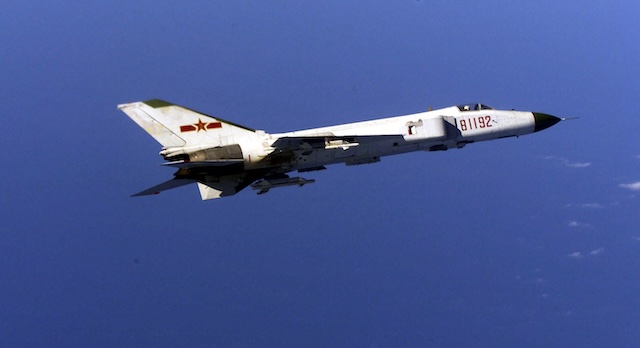J-8 Finback
Summary
| Category | Combat Aircraft |
| Origin country | 🇨🇳 China |
| Manufacturer | Shenyang |
| First flight | 5 July 1969 |
| Year introduced | 1980 |
| Number produced | 408 units |
Description
The Shenyang J-8 was conceived in the early 1960s as a low-risk program based on enlarging the Mikoyan-Gurevich MiG-21F, a version of which the PRC was producing as the Chengdu J-7. This decision was made because the Chengdu J-7 was deemed inadequate to perform long-range, high-altitude interceptions by 1964. The 601 Institute had two proposals: a twin-engined "scaled-up" J-7 which became the J-8, and a higher-performing single-engined option that became the Chengdu J-9. Both options were pursued, but the J-8 offered lower technical risk and received higher priority and political support, leading to the J-9 being cancelled in 1980. The program suffered disruptions into the 1970s, including the death of Huang Zhiqian in an air crash in May 1965, and difficulties stemming from the Cultural Revolution. The first prototype, "001 Red" made its first successful flight on 5 July 1969 piloted by Yin Yuhuan. Flight and static testing revealed problems, including severe buffeting at transonic and supersonic speeds, overheating of the rear fuselage at supersonic speeds, engine unreliability, and airframe weaknesses. The design was finalized on 31 December 1979, and formally entered service on 2 March 1980.
The original J-8 shared features with the J-7, including the front-hinged single-piece cockpit canopy, landing gear design, and positioning of the ventral air brakes, with the tail having two ventral fins similar in shape to the J-7's single ventral fin. Powered by two Liyang WP-7B afterburning turbojets, it featured a nose intake with a small inlet cone enclosing a radar rangefinder. It was initially equipped with two Type 30-1 (Nudelman-Rikhter NR-30) cannons mounted under the cockpit.
Later, the J-8II/J-8B saw 70% of its airframe structure and systems reworked, replacing the nose air intake with an ogival radome and lateral air intakes for a larger Type 208 pulse-Doppler radar, and replacing the two ventral fins with a single larger one copied from the MiG-23.
The J-8's armament evolved through its various iterations. The initial J-8 variant was equipped with two Type 30-1 (Nudelman-Rikhter NR-30) cannons mounted under the cockpit, and three hardpoints (one under each wing and one on the centerline) providing a total carrying capacity of 2.5 tonnes. The J-8A replaced the Type 30-1 cannons with Type 23-III (Gryazev-Shipunov GSh-23L) cannons and used the PL-2B and PL-5 missiles. The J-8B carried a single Type 23-III cannon and increased the number of external hardpoints to seven. The F-8 IIM variant featured one 23mm Type 23-III cannon, along with one centerline and six under-wing hardpoints capable of carrying three drop tanks, rockets, a mix of PL-5, PL-9, R-27R1, PL-11 AAMs, or Kh-31 anti-ship missiles, and bombs. It could accommodate 5 x low drag 500 kg (1,100 lb) or 10 x 250 kg (550 lb) bombs.
The J-8 family has served primarily within the People's Liberation Army Air Force (PLAAF) and the People's Liberation Army Naval Air Force (PLANAF) and has not been exported extensively. The aircraft's operational history includes interceptor duties, providing air defense for China's territory and naval assets. A notable event in the J-8's operational record is the collision between a J-8B and a United States Navy EP-3E ARIES II signals intelligence aircraft in April 2001, which resulted in the loss of the Chinese pilot and caused an international incident. Perceived strengths included high speed and long range, while perceived weaknesses included dated avionics compared to more modern designs.
Main Variants:
-
J-8: This was the original version of the aircraft, also known by its NATO reporting name, Finback-A.
-
J-8A: An improved variant of the J-8, equipped with the SR-4 radar system and capable of deploying air-to-air missiles; it was initially designated as the J-8 I.
-
J-8 IE: This was a further enhancement of the J-8A, featuring upgraded avionics, notably including the JL-7 radar system, and these were converted from the J-8A model following the development of the J-8B.
-
J-8B: A radically redesigned version of the J-8 incorporating the Type 208 pulse-Doppler radar, WP-13A-II turbojets, and an increased payload capacity, originally designated J-8 II and known by the NATO reporting name Finback-B.
-
J-8D: An improved version of the J-8B, featuring an IFR (In-Flight Refueling) probe and avionics similar to those found in the J-8B Block 02, also known by the NATO reporting name Finback-B Mod.
Technical specifications
| Version: J-8 Finback-A | |
|---|---|
| Maximum speed | 2300 km/h (1429 mph) |
| Wingspan | 9.3 m (30.7 ft) |
| Height | 5.4 m (17.7 ft) |
| Length | 21.5 m (70.6 ft) |
| Service ceiling | 18,000 m (59,055 ft) |
| Empty weight | 10,371 kg (22,864 lbs) |
| Max. takeoff weight | 18,879 kg (41,621 lbs) |
| Climb rate | 224.0 m/s (734.9 ft/s) |
| Takeoff distance | 630 m (2,067 ft) |
| Powerplant | 2 x Guizhou WP-13B turbojet engines delivering 4794 kgf each |
Current operating countries
| Country | Units | ||
|---|---|---|---|

|
China | 143 | |
All operators
